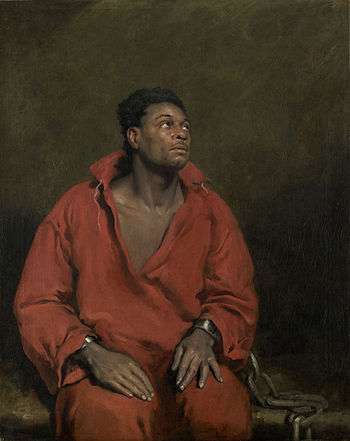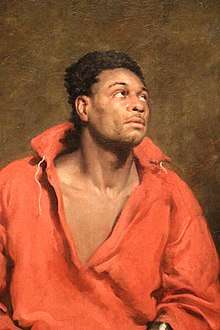The Captive Slave
The Captive Slave is a portrait painted by the artist John Simpson (1782–1847), which was first exhibited in London in 1827. It shows a man, manacled, on a stone bench and looking pensively or plaintively upward. Its subject matter, historical period, and mode of creation suggest the artist intended the painting as a statement against slavery. Until acquired by the Art Institute of Chicago in 2008, it had not been displayed to the public for 180 years.
| The Captive Slave | |
|---|---|
 | |
| Artist | John Philip Simpson |
| Year | 1827 |
| Medium | Oil on canvas |
| Dimensions | 127 cm. × 101.5 cm. (50 in. × 40 in.) |
| Location | Art Institute of Chicago |
Simpson's painting
The three-quarter portrait shows a dark-skinned man in orange-red open collar clothing, sitting on a stone bench, against a muted background, with the sitter taking up most the frame. Large metallic manacles are visible around his wrists, which lie on his lap, and a heavy chain falls across the bench and out of the frame. The man is gazing up and to his left.[1][2]
At its original showing it was entitled, The Captive Slave, and the viewer is informed of the sitter's condition as a slave by the manacles and by his dark skin, which connects him to the African slave trade.[3] His clothes suggest somewhat foreign origin but also prison garb. The features of the subject show the man as a recognizable individual person. The painting is described as a portrait but also a hybrid with genre painting, as the name of the character in the painting is unknown.[1][3] His aspect is saintly[1] or heroic,[2] imploring, vulnerable, and somewhat passive in rest, which allowed the British viewer when the portrait was shown to safely sympathize or pity the subject and deplore his condition.[3] While the portrait follows high art conventions for depicting the saintly or long suffering, portraits of individual slaves were rare in the European high art tradition.[1]
Artist and artwork
The artist, John Simpson, was a British portrait painter, who studied at the Royal Academies, and was a longtime assistant of the portraitist Thomas Lawrence. Today, Simpson is described as "little known".[1] The painting was created on a used canvas that x-rays show had previously depicted a stately home and another portrait; this reuse suggests that the artist did not paint it on commission, which is how he made his living, but here he appears to have chosen the subject of his own volition. The portrait was displayed in London at the Royal Academy not once but twice, in 1827 and again in 1828; it was also displayed at an exhibition at the Liverpool Academy in 1828. Several contemporary reviews at that time noted the pathos that the painting evoked, and associated the painting with "radical" or "sentimental" anti-slavery literature.[4]
In this period, Britain was debating whether to abolish slavery throughout its empire. The British slave trade had been outlawed in 1807, but abolition was still a pressing political question in the late 1820s. Against this background, the two London showings and the showing in Liverpool, "a city synonymous with the slave trade, and whose merchants continued to prosper from [slavery]"[1] is seen as significant. The artist included lines of William Cowper' poetry in the first exhibition catalogue: "Ah but! what wish can prosper or what prayer/for merchants rich in cargoes of despair" (from the poem, Charity, 1784). Reviewer Martin Postle concludes:
Despite enduring critical neglect and eventual obscurity, Simpson was a gifted artist, capable at times of venturing beyond the parameters of society portraiture and his position as a studio assistant. And in one particular work, The Captive Slave, John Simpson produced a painting of iconic status, which can be regarded today as his masterpiece and as a worthy emblem of the aims and achievements of the Abolition Movement.[1]

The model for the painting is thought to be the American-born actor Ira Aldridge.[2][5] Aldridge was born a free negro and educated in New York City, he left America because of the lack of serious acting opportunities there for a black man. He went on to become a successful Shakespearean actor in Europe, despite sometimes racist comments from theater critics.[1]
Provenance
Simpson's painting was sold in Dublin from a private collection in 1996, at the time a label on the frame read "J. Simpson, The Slave". A private British collector later sold it to an art dealer, who sold it to the Art Institute of Chicago in 2008. Prior to the acquisition by the museum where it underwent scientific testing, the painting had not been displayed to the general public for 180 years.[1][6] What is now considered to be a copy from an unknown hand is in the collection of the Wilberforce House museum in Hull, England.[7]
References
- Postle, Martin (Spring 2009). "The Captive Slave by John Simpson (1782–1847): A rediscovered masterpiece". The British Art Journal. 9 (3): 18–26. JSTOR 41614836.
- "About This Artwork: The Captive Slave". Art Institute of Chicago. Retrieved 14 February 2015.
- Agnes Lugo-Ortiz and Angela Rosenthal, editors (2013). Slave Portraiture in the Atlantic World. Cambridge University Press. pp. 17–18. ISBN 9781107004399.
- Curtis, Penelope, ed. (6 May 2014). Tate Britain companion : a guide to British art. p. 66. ISBN 978-1-84976-033-1. OCLC 825559755.
- Myrone, Martin (September 2013). "John Simpson, Head of a Man (?Ira Frederick Aldridge) exhibited 1827". Tate Britain. Retrieved 14 February 2015.
- "Art Institute Announces Major Acquisition of Landmark British Painting, Simpson's Rediscovered Captive Slave Bold Anti-Slavery Statement - First Public Exhibition of Work in 180 Years" (Press release). Art Institute of Chicago. 2008. Retrieved 14 February 2015.
- "The Captive Slave - National Maritime Museum". Royal Museums Greenwich. Retrieved 2018-02-13.